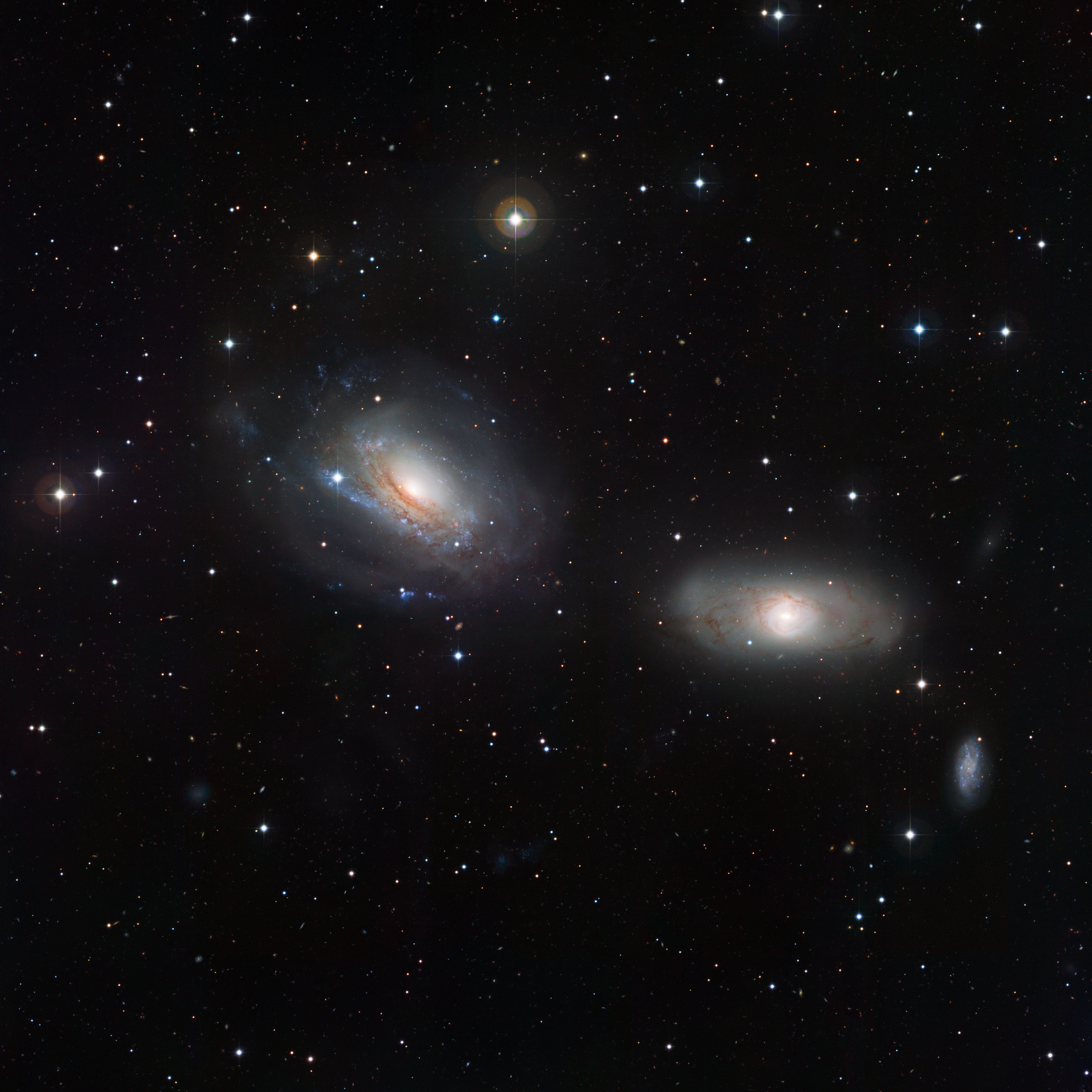Colliding Galaxies on:
[Wikipedia]
[Google]
[Amazon]
 Interacting galaxies (''colliding galaxies'') are
Interacting galaxies (''colliding galaxies'') are
27 March 2010
/ref>
File:Galactic Creatures at Play.jpg,
 Galactic cannibalism is a common phenomenon that occurs in the universe, which refers to the process in which a large
Galactic cannibalism is a common phenomenon that occurs in the universe, which refers to the process in which a large

Galaxy CollisionsGalactic Collision SimulationGALMER: Galaxy Merger Simulations
{{DEFAULTSORT:Interacting Galaxy Extragalactic astronomy Articles containing video clips
 Interacting galaxies (''colliding galaxies'') are
Interacting galaxies (''colliding galaxies'') are galaxies
A galaxy is a system of stars, stellar remnants, interstellar gas, dust, dark matter, bound together by gravity. The word is derived from the Greek ' (), literally 'milky', a reference to the Milky Way galaxy that contains the Solar System. ...
whose gravitational fields
In physics, a gravitational field is a model used to explain the influences that a massive body extends into the space around itself, producing a force on another massive body. Thus, a gravitational field is used to explain gravitational phenome ...
result in a disturbance of one another. An example of a minor interaction is a satellite galaxy disturbing the primary galaxy's spiral arms. An example of a major interaction is a galactic collision, which may lead to a galaxy merger.
Satellite interaction
A giant galaxy interacting with itssatellites
A satellite or artificial satellite is an object intentionally placed into orbit in outer space. Except for passive satellites, most satellites have an electricity generation system for equipment on board, such as solar panels or radioisotop ...
is common. A satellite's gravity could attract one of the primary's spiral arms. Alternatively, the secondary satellite can dive into the primary galaxy, as in the Sagittarius Dwarf Elliptical Galaxy diving into the Milky Way. That can possibly trigger a small amount of star formation
Star formation is the process by which dense regions within molecular clouds in The "medium" is present further soon.-->interstellar space
. Such orphaned clusters of stars were sometimes referred to as "blue blobs" before they were recognized as stars.
Galaxy collision
Colliding galaxies are common duringgalaxy evolution
The study of galaxy formation and evolution is concerned with the processes that formed a heterogeneous universe from a homogeneous beginning, the formation of the first galaxies, the way galaxies change over time, and the processes that have gen ...
. The extremely tenuous distribution of matter in galaxies means these are not collisions in the traditional sense of the word, but rather gravitational interactions.
Colliding may lead to merging if two galaxies collide and do not have enough momentum to continue traveling after the collision. As with other galaxy collision
Interacting galaxies (''colliding galaxies'') are galaxies whose gravitational fields result in a disturbance of one another. An example of a minor interaction is a satellite galaxy disturbing the primary galaxy's spiral arms. An example of a ...
s, the merging of two galaxies may create a starburst region of new stars. In that case, they fall back into each other and eventually merge into one galaxy after many passes through each other. If one of the colliding galaxies is much larger than the other, it will remain largely intact after the merger. The larger galaxy will look much the same, while the smaller galaxy will be stripped apart and become part of the larger galaxy. When galaxies pass through each other, unlike during mergers, they largely retain their material and shape after the pass.
Galactic collisions are now frequently simulated on computers, which use realistic physics principles, including the simulation of gravitational forces, gas dissipation phenomena, star formation, and feedback. Dynamical friction slows the relative motion galaxy pairs, which may possibly merge at some point, according to the initial relative energy of the orbits.
A library of simulated galaxy collisions can be found at the Paris Observatory website: GALMER
GALME27 March 2010
/ref>
Gallery
UGC 2369
UGC 2369 is a pair of galaxies and interacting galaxies in the constellation Aries, about 424 million light-years away. The two galaxies are called UGC 2369N and UGC 2369S.
Interaction between galaxies is not an uncommon event, however, two simi ...
taken by HST.
File:Close encounter IRAS 06076-2139.jpg, Close encounter at IRAS 06076-2139
The Infrared Astronomical Satellite ( Dutch: ''Infrarood Astronomische Satelliet'') (IRAS) was the first space telescope to perform a survey of the entire night sky at infrared wavelengths. Launched on 25 January 1983, its mission lasted te ...
.
File:NGC 4298 and NGC 4302 - Heic1709a.jpg, Interacting galaxies NGC 4302
NGC 4302 is an edge-on spiral galaxy located about 55 million light-years away in the constellation Coma Berenices. It was discovered by astronomer William Herschel on April 8, 1784 and is a member of the Virgo Cluster.
It is classified as a Sey ...
and NGC 4298 both located 55 million light-years away.
File:NGC 6052.jpg, Galaxy NGC 6052
NGC 6052 is a pair of galaxies in the constellation of Hercules. It was discovered on 11 June 1784 by William Herschel. It was described as "faint, pretty large, irregularly round" by John Louis Emil Dreyer, the compiler of the New General Catalog ...
merging into a single structure.
File:Galactic soup.jpg, Galaxy pair Zw I 136.
File:The messy result of a galactic collision.jpg, ESO 576-69
The European Organisation for Astronomical Research in the Southern Hemisphere, commonly referred to as the European Southern Observatory (ESO), is an intergovernmental research organisation made up of 16 member states for ground-based ast ...
is believed to be the nucleus of a former spiral galaxy.
File:Whirlpool (M51).jpg, The Whirlpool Galaxy with its satellite NGC 5195
NGC 5195 (also known as Messier 51b or M51b) is a dwarf galaxy that is interacting with the Whirlpool Galaxy (also known as M51a or NGC 5194). Both galaxies are located approximately 25 million light-years away in the constellation Canes Venatic ...
.
File:NGC4676.jpg, The Mice Galaxies
NGC 4676, or the Mice Galaxies, are two spiral galaxies in the constellation Coma Berenices. About 290 million light-years distant, they have begun the process of colliding and merging. Their name refers to the long tails produced by tidal actionâ ...
.
File:Colliding Galaxies Create Active Galactic Nuclei.OGG, This simulation follows the collision of two spiral galaxies that harbour giant black holes.
File:Defying cosmic convention.jpg, NGC 3447
NGC commonly refers to:
* New General Catalogue of Nebulae and Clusters of Stars, a catalogue of deep sky objects in astronomy
NGC may also refer to:
Companies
* NGC Corporation, name of US electric company Dynegy, Inc. from 1995 to 1998
* Na ...
comprises a couple of interacting galaxies.
File:NGC 1510 and NGC 1512 in UV Light.jpg, Barred spiral galaxy NGC 1512 in the process of a lengthy merger with dwarf elliptical galaxy NGC 1510.
File:Hubble Interacting Galaxy ESO 593-8 (2008-04-24).jpg, ESO 593-8
ESO 593-8, which is known simply as 'The Bird' (also ESO 593-IG 008 or IRAS 19115–212) is group of interacting galaxies located in the constellation of Sagittarius, 650 million light-years away from Earth. It was created by a merger of two spi ...
is an impressive pair of interacting galaxies with a feather-like galaxy crossing a companion galaxy.
Galactic cannibalism
 Galactic cannibalism is a common phenomenon that occurs in the universe, which refers to the process in which a large
Galactic cannibalism is a common phenomenon that occurs in the universe, which refers to the process in which a large galaxy
A galaxy is a system of stars, stellar remnants, interstellar gas, dust, dark matter, bound together by gravity. The word is derived from the Greek ' (), literally 'milky', a reference to the Milky Way galaxy that contains the Solar System. ...
, through tidal gravitational interactions with a companion, merges with that companion; that results in a larger, often irregular galaxy.
The most common result of the gravitational merger between two or more galaxies is an irregular galaxy, but elliptical galaxies may also result.
It has been suggested that galactic cannibalism is currently occurring between the Milky Way and the Large and Small Magellanic Clouds. Streams of gravitationally-attracted hydrogen arcing from these dwarf galaxies to the Milky Way is taken as evidence for the theory.
Galaxy harassment
Galaxy harassment is a type of interaction between a low-luminosity galaxy and a brighter one that takes place within rich galaxy clusters, such as Virgo andComa
A coma is a deep state of prolonged unconsciousness in which a person cannot be awakened, fails to respond normally to painful stimuli, light, or sound, lacks a normal wake-sleep cycle and does not initiate voluntary actions. Coma patients exhi ...
, where galaxies are moving at high relative speed
The relative velocity \vec_ (also \vec_ or \vec_) is the velocity of an object or observer B in the rest frame of another object or observer A.
Classical mechanics
In one dimension (non-relativistic)
We begin with relative motion in the classi ...
s and suffering frequent encounters with other systems of the cluster by the high galactic density of the latter.
According to computer simulation
Computer simulation is the process of mathematical modelling, performed on a computer, which is designed to predict the behaviour of, or the outcome of, a real-world or physical system. The reliability of some mathematical models can be dete ...
s, the interactions convert the affected galaxy disks into disturbed barred spiral galaxies
A barred spiral galaxy is a spiral galaxy with a central bar-shaped structure composed of stars. Bars are found in about two thirds of all spiral galaxies, and generally affect both the motions of stars and interstellar gas within spiral galaxies ...
and produces starbursts followed by, if more encounters occur, loss of angular momentum and heating of their gas.
The result would be the conversion of (late type) low-luminosity spiral galaxies into dwarf spheroidals and dwarf ellipticals.
Evidence for the hypothesis had been claimed by studying early-type dwarf galaxies in the Virgo Cluster and finding structures, such as disks and spiral arms, which suggest they are former disk systems
Disk or disc may refer to:
* Disk (mathematics), a geometric shape
* Disk storage
Music
* Disc (band), an American experimental music band
* ''Disk'' (album), a 1995 EP by Moby
Other uses
* Disk (functional analysis), a subset of a vector space ...
transformed by the above-mentioned interactions. However, the existence of similar structures in isolated early-type dwarf galaxies, such as LEDA 2108986
LEDA 2108986, also known by its Case Western Reserve University designation "Case Galaxy 611" (CG 611), is an extremely isolated, early-type dwarf galaxy with an embedded spiral structure residing in what is likely an intermediate-scale disk.
...
, has undermined this hypothesis
Notable interacting galaxies

Future collision of the Milky Way with Andromeda
Astronomers have estimated the Milky Way Galaxy will collide with the Andromeda Galaxy in about 4.5 billion years. It is thought that the two spiral galaxies will eventually merge to become an elliptical galaxywhose gravitational interactions will fling various celestial bodies outward, evicting them from the resulting elliptical galaxy. Astronomy, June 2008, page 28, by Abraham Loeb and T.J.Cox or perhaps a large disk galaxy.See also
* NGC 7318References
External links
Galaxy Collisions
{{DEFAULTSORT:Interacting Galaxy Extragalactic astronomy Articles containing video clips